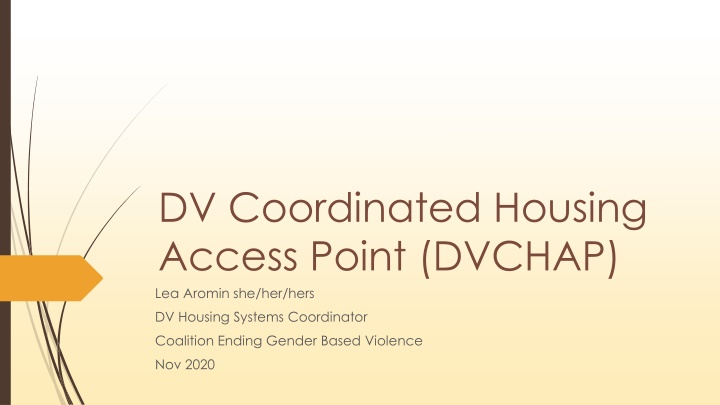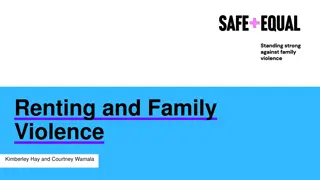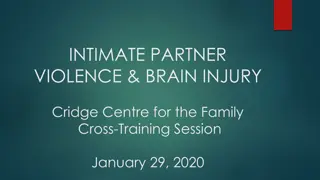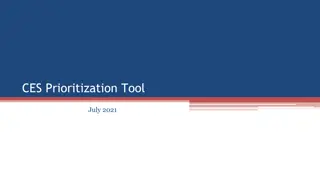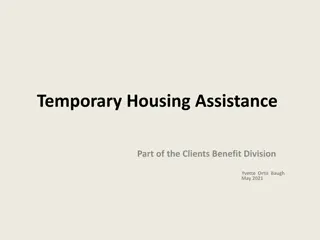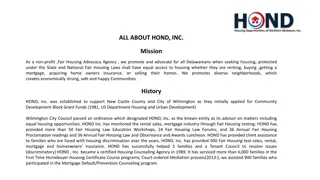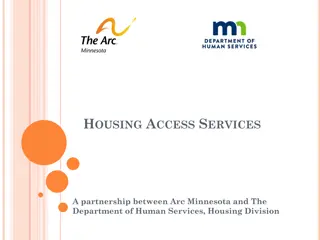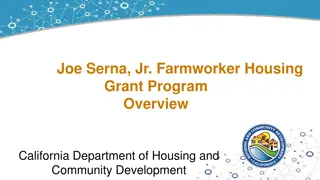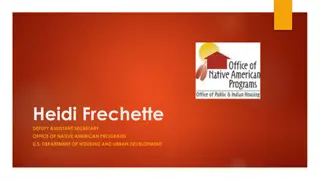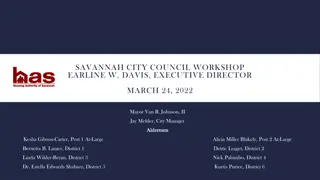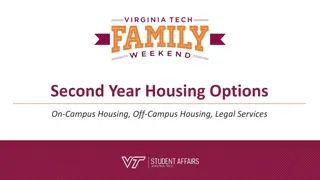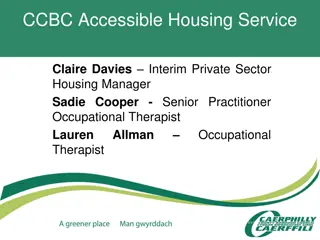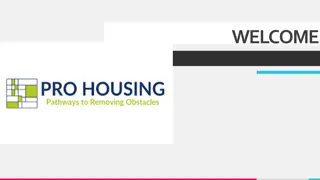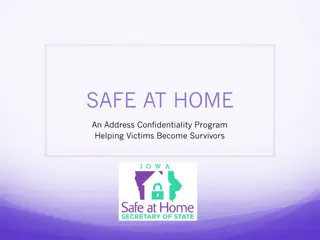DV Coordinated Housing Access Point - Strengthening Connections for DV Survivors
DV Coordinated Housing Access Point (DVCHAP) functions as a parallel system to mainstream Coordinated Entry for All in King County, coordinating access for DV survivors into housing resources. Learn about its historical background, goals, and available resources to support survivors in need.
Download Presentation

Please find below an Image/Link to download the presentation.
The content on the website is provided AS IS for your information and personal use only. It may not be sold, licensed, or shared on other websites without obtaining consent from the author.If you encounter any issues during the download, it is possible that the publisher has removed the file from their server.
You are allowed to download the files provided on this website for personal or commercial use, subject to the condition that they are used lawfully. All files are the property of their respective owners.
The content on the website is provided AS IS for your information and personal use only. It may not be sold, licensed, or shared on other websites without obtaining consent from the author.
E N D
Presentation Transcript
DV Coordinated Housing Access Point (DVCHAP) Lea Aromin she/her/hers DV Housing Systems Coordinator Coalition Ending Gender Based Violence Nov 2020
Goals Tell you about the DV Coordinated Housing Access Point (DVCHAP)! Hear from you, get your input! Strengthen existing connections, build new ones!
Take notes! QUESTION: what are you curious about or want to hear more on? HOPE: what do you feel hopeful about? CONCERN: what do you feel concern about? MISSING: what do you think is missing? Drop in the chat or hold on to it until we do breakout sessions! Take Notes!
Domestic Violence Coordinated Housing Access Point (DVCHAP) Function as a parallel system to mainstream Coordinated Entry for All in King County Coordinates access for DV survivors into DV Housing resources Needs to have the same core components of all Coordinated Entry systems Housing and Urban Development (HUD) mandate Risk of noncompliance - absorbed back mainstream CEA system Brief history and background 2012 CE implemented in King County DV programs were part of the system 2014 CEGV/Member orgs were requested waiver to opt out of the system 2015 DV Housing Providers implemented their own informal process 2019 DVHSC hired to formally coordinate and solidify DVCE process
Historical Background and Context 2012 Mandate from Department of Housing and Urban Development. King County launched coordinated entry process via CCS, Family Housing Connections: 30 agencies, 90 programs Shelter, THP, RRH, RA, PH Included DV programs 2014 CEGV and Member agencies requested and granted a waiver out of the system. Report on King County CE found that survivors were not served well by the system. 2015 DV providers implemented their own informal process, including a Common Application and started meeting on a semi-regular basis to solidify coordination. 2018 Steering Committee developed formal plan for DVCE. 2019 DV Housing Systems Coordinator funded through HUD DV Bonus Funds to build on current approach.
DVCHAP Resources 19 Individual units in confidential location; referrals are taken from the deaf community first and opened up to the DV community second 1. Abused Deaf Women s Advocacy Services (ADWAS) A Place of Our Own Supportive Housing (PH)* 2. Broadview Domestic Violence Transitional Housing Program Individual units in confidential location for up to 12 months Financial assistance, advocacy, housing search for up to 12 months 3. Broadview Rapid Rehousing Program 4. Consejo Mi Casa Transitional Housing Program 4 rooms for families in communal space for up to 24 months 5. Consejo Villa Esperanza Transitional Housing Program 23 Individual units in confidential location for up to 24 months 5 Individual units for families in confidential location for up to 24 months 10 Transitional housing combined rapid rehousing program for up to 6-12 months, specific to survivors in recovery from substance use Financial assistance, advocacy, housing search for up to 12 months Financial assistance, advocacy, housing search for up to 12 months 10 Transitional housing combined rapid rehousing program for up to 6-12 months Financial assistance, advocacy, housing search for up to 12 months 6. InterIm CDA Solace Domestic Violence Transitional Housing Program 7. LifeWire My Friend s Place DV Transitional Housing/RRH Joint Component 8. LifeWire Rapid Rehousing Program 9. LifeWire Rental Assistance Program 10. The Salvation Army Hickman House DV Transitional Housing Program and RRH/Joint Component 11. YWCA Rapid Rehousing Program 12. YWCA Anita Vista Transitional Housing Program 14 Individual units in confidential location for up to 12 months 17 short term residential housing combined rapid rehousing program; referrals taking through their helpline 13. New Beginnings City of Seattle RRH Program/Joint Component model with Bridge Housing * 6 individual units in confidentiallocation 14. DAWN Permanent Housing, Liberty Square (PH)
A process that will be survivor- centered, focusing on what works best for survivors, rather than for advocates, programs or agencies A low-barrier, transparent path to housing options that is easily understood and equitable, reducing the burden placed on survivors to navigate a complicated system Demonstrate a clear commitment to increasing racial equity and addressing disproportionality within the domestic violence housing system Incorporate survivor and community feedback for continuous improvement DVCHAP Guiding Principles
Create a clear and consistent way for survivors to access DV housing wherever they may be referred from Create a clear and consistent assessment tool, prioritization criteria and standard decision-making process to be used by all DV Housing providers Cultivate a culture of trust and collaboration among DV Housing Providers and among the larger community of gender based violence providers in the region DVCHAP Goals Provide clear and consistent messaging to survivors, providers and the larger community about the structure, purpose, benefits and limitations of the system
Our Current System: What It Looks Like Now DV Housing Provider makes decision on which household to offer the resource using their own prioritization criteria and referral process. DV Housing Providers send out notice of opening/s to all Gender Based Violence programs in King County (some in Sno and Pierce). Staff fill out the Common Application with DV survivor and submit to the DV Housing Provider before closing date. Household is offered the resource. Via email and on Day One
DVCHAP Workgroup Representatives from DV Housing providers and a handful of others from DV programs with no DV-specific housing have met 1-2x a month since August 2019. Key staff, consistent attendance. SG Broadview YWCA Consejo Counseling and Referral Services LifeWire InterIm CDA Salvation Army Hickman House New Beginnings Salvation Army CAP DAWN Refugee Women s Alliance (REWA) NW Network Jewish Family Services Project DVORA
Initial Community Feedback Met late in 2019 and through Spring of 2020 with other agencies that are not part of the DVCHAP workgroup to introduce myself and my work, get feedback of the drafts of the system that we currently had. Mother Nation API Chaya DOVE Project Seattle Indian Health Board Mary s Place* Northwest Immigrant Rights Project ADWAS* Atlantic Street Center REWA* Somali Family Safety Task Force
Our Current System: What It Looks Like Now DV Housing Provider makes decision on which household to offer the resource using their own prioritization criteria and referral process. DV Housing Providers send out notice of opening/s to all Gender Based Violence programs in King County (some in Sno and Pierce). Staff fill out the Common Application with DV survivor and submit to the DV Housing Provider before closing date. Household is offered the resource. Via email and on Day One
Proposed DVCHAP System Flow Cross Agency Case Conferencing is scheduled Offer Resource to Household Final Final Prioritization: Discuss barriers to safety and housing Prioritization: Assess for disproportional ity DV Housing Provider posts notification that opening has been filled DV Housing Provider receives joint application assessment via secure email and/or TBD portal DV Housing Provider posts notification of opening Initial Prioritization: 1. Assess for Disproportionality 2. DV Impact Score F/u with households not offered resource Resource database (i.e. Day One) communicated to callers on the DV Centralized Helpline Consensus on initial prioritization results Explore other options for all households outside of the primary resource Email listserv of Gender Based Violence Providers in King, Sno, Pierce County Which households are furthest from access to resources and experience the most vulnerability? Consensus on final decision TBD providers who are close partners of GBV providers Create co-advocacy plan/s, if applicable
Proposed DVCHAP System Flow: ACCESS Cross Agency Case Conferencing is scheduled Offer Resource to Household Final Final Prioritization: Discuss barriers to safety and housing Prioritization: Assess for disproportional ity DV Housing Provider posts notification that opening has been filled DV Housing Provider receives joint application assessment via secure email and/or TBD portal DV Housing Provider posts notification of opening Initial Prioritization: 1. Assess for Disproportionality 2. DV Impact Score F/u with households not offered resource Resource database (i.e. Day One) communicated to callers on the DV Centralized Helpline Consensus on initial prioritization results Explore other options for all households outside of the primary resource Email listserv of Gender Based Violence Providers in King, Sno, Pierce County Which households are furthest from access to resources and experience the most vulnerability? Consensus on final decision TBD providers who are close partners of GBV providers Create co-advocacy plan/s, if applicable
Three access points to DVCHAP DV Centralized Helpline Email listserv of GBV providers in King, Sno, and Pierce Counties Secondary list of close community partners (TBD) Step 1 Access DV Housing Provider posts opening to listserv of GBV providers via email and Gender Based Violence Resource Database (aka Day One) DV Housing Provider gathers submitted assessment packets
Proposed DVCHAP System Flow: ASSESSMENT Cross Agency Case Conferencing is scheduled Offer Resource to Household Final Final Prioritization: Discuss barriers to safety and housing Prioritization: Assess for disproportional ity DV Housing Provider posts notification that opening has been filled DV Housing Provider receives joint application assessment via secure email and/or TBD portal DV Housing Provider posts notification of opening Initial Prioritization: 1. Assess for Disproportionality 2. DV Impact Score F/u with households not offered resource Resource database (i.e. Day One) communicated to callers on the DV Centralized Helpline Consensus on initial prioritization results Explore other options for all households outside of the primary resource Email listserv of Gender Based Violence Providers in King, Sno, Pierce County Which households are furthest from access to resources and experience the most vulnerability? Consensus on final decision TBD providers who are close partners of GBV providers Create co-advocacy plan/s, if applicable
How did we decide on the structure, the questions, the flow? Reviewed assessment tools of DV parallel and integrated systems around the nation Looked at the pros and cons of the current VISPDAT Reviewed current screening and assessment tools at DV agencies in King County Discussion about different tensions that having an assessment tool brings up Step 2 Assessment
DVCHAP Joint Application/Assessment is a phased assessment of three parts. Part 1 Eligibility check program description ensures that the households understand the program and are making an informed decision to move forward (1 page) Part 2 DV Narrative provides space to capture the household s experience of DV as it has led up to their current housing instability (1 page) Part 3 Full Assessment of Resources and Barriers guided conversation that gathers information for prioritization and exploration of housing options (3 pages) Step 2 Assessment
Highlights of the Joint Application Assessment Conversations about explicit and implicit tensions Brevity v. thoroughness Survivor s stated request/need v. advocate knowledge of services, criteria, availability Threading the acknowledgement of systemic racism and its varied impacts on a household s experience of DV and housing instability Reframing community
Who gets trained on the new tool? Gender based violence agency staff must be trained on the DVCHAP joint application assessment to submit on behalf of the survivors they're working with Step 1 Initial training at rollout will be mandatory for any one that would be filling out and submitting Access Refresher and New Hire training will be a combination of webinar and interactive format This will be done via the DV agency itself as part of their internal training or by the DVHSC The webinar will be developed and maintained by CEGV Training materials will be developed and maintained by CEGV for DV agencies that opt to train their own staff ongoing Key orgs that are identified as close partners of gender based violence agencies will be trained to complete Part 1 and 2 of the tool: Eligibility Check and DV Narrative. Initial training will be conducted by CEGV/DVHSC and will be mandatory for any one that would be filling out and submitting Step 2 Assessment Refresher and New Hire training will be a combo of webinar and interactive format This will be done via the DV agency that they partner closely with or by CEGV/DVHSC, if no DV agencies have the capacity Individuals will be required to attend a refresher training annually to keep abreast of changes and updates to the assessment tool and DVCHAP process CEGV/DVHSC will track who has received the assessment training and is eligible to fill out and submit
Proposed DVCHAP System Flow: PRIORITIZATION Cross Agency Case Conferencing is scheduled Offer Resource to Household Final Final Prioritization: Discuss barriers to safety and housing Prioritization: Assess for disproportional ity DV Housing Provider posts notification that opening has been filled DV Housing Provider receives joint application assessment via secure email and/or TBD portal DV Housing Provider posts notification of opening Initial Prioritization: 1. Assess for Disproportionality 2. DV Impact Score F/u with households not offered resource Resource database (i.e. Day One) communicated to callers on the DV Centralized Helpline Consensus on initial prioritization results Explore other options for all households outside of the primary resource Email listserv of Gender Based Violence Providers in King, Sno, Pierce County Which households are furthest from access to resources and experience the most vulnerability? Consensus on final decision TBD providers who are close partners of GBV providers Create co-advocacy plan/s, if applicable
Initial Prioritization: Narrowing the Pool Part 1 Which households are disproportionately impacted by domestic violence AND homelessness? Homelessness Black and African Americans; people who identify as Latinx, Native, or Pacific Islander; individuals with disabilities; people who identify as lesbian, gay, bisexual, transgender, and queer (LGBTQ); incarcerated and formerly incarcerated individuals; undocumented individuals and mixed- immigration-status families and communities. Native and Pacific Islander Black and African American LGBTQ Survivors with disabilities Immigrant survivors and undocumented household Step 3 Prioritization Domestic Violence
Initial Prioritization: Narrowing the Pool Part 2 DV IMPACT SCORE Ask the question: Who is furthest away from the options and resources needed to get more safety and stability? Looking at different life domains - What is the impact of DV? How has DV impacted the household? Step 3 Prioritization Who is furthest away from opportunities to repair harm? Put that on a scale of 1-5 Recognition that the true impact of DV cannot be quantified, is often invisible, may only manifest later on in many intangible and intangible ways Similar issue to scoring for vulnerability How do you put a number to the complexity of someone s trauma? Who is responsible for the scoring? Key staff at agency receiving assessments
How has domestic violence impacted these life domains? Civil Legal Issues Housing and Economic Well- Being Mental Health and Substance use Education and Employment Physical Health/Healthcare Criminal History Community Support and Connection Child Welfare Involvement/Child Well-Being
Initial Prioritization: Narrowing the Pool Score between 1-5 Other questions: How do you conceptualize words like: Impact, Barriers, Options , Safety, Restore, Access, etc? 1 little to no identified/known impact DV has had little to no impact in this area and there is ready access to resources and options 2 some impact there are enough resources and options to restore safety and stability and survivor has access with little to no support 3 moderate there are still resources and options to restore safety and stability and access is possible with support; more than there are barriers 4 high there are less options and resources to move forward and restore safety and stability; perhaps equal to the barriers present; access is limited 5 long term there are more barriers than there are options; intensive advocacy and resources are critical; without which there would be little to no access
Proposed DVCHAP System Flow PRIORITIZATION Cross Agency Case Conferencing is scheduled Offer Resource to Household Final Final Prioritization: Discuss barriers to safety and housing Prioritization: Assess for disproportional ity DV Housing Provider posts notification that opening has been filled DV Housing Provider receives joint application assessment via secure email and/or TBD portal DV Housing Provider posts notification of opening Initial Prioritization: 1. Assess for Disproportionality 2. DV Impact Score F/u with households not offered resource Resource database (i.e. Day One) communicated to callers on the DV Centralized Helpline Consensus on initial prioritization results Explore other options for all households outside of the primary resource Email listserv of Gender Based Violence Providers in King, Sno, Pierce County Which households are furthest from access to resources and experience the most vulnerability? Consensus on final decision TBD providers who are close partners of GBV providers Create co-advocacy plan/s, if applicable
Final Prioritization: Bring to the Cross Agency Case Conferencing DV Housing Provider identifies a date and time to convene case conferencing group made up of DVCHAP Workgroup providers [+ agencies serving marginalized communities] to prioritize and make placement decisions Virtual meetings indefinitely Prioritize timeframe that works best for the DV Housing Provider that is hosting DV Housing Systems Coordinator will provide support with convening the group Size of group will be determined depending on size of host team but will not exceed 8-10 people Sends invitations to providers eligible to join case conferencing, including DV Housing Systems Coordinator DV Housing Systems Coordinator will provide facilitation support, as needed. Step 3 Prioritization
Final Prioritization: Bring to the Group Shared Case Conferencing Gather top 5 assessments with the highest score Group will have looked at the tracking spreadsheet before the meeting Allow time to ask questions about the other households that did not make it to the pool and why Step 3 Fist to Five consensus that these are the households that will be discussed; okay to disagree and make adjustments to who is in the pool for discussion Prioritization Fist a no vote, a way to block consensus. I need more information about the issues and require changes for this to pass. 1 Finger I need to discuss certain issues and can suggest changes that should be made. 2 Fingers I am comfortable with the proposal but want to discuss it further. 3 Fingers I m not in total agreement but feel comfortable enough to let this decision pass without further discussion. 4 Fingers I think this is a reasonable idea and am not opposed. 5 Fingers It s a great idea and I am a major supporter.
Determine Final Prioritization: Last Step Once there is consensus of which households will be discussed facilitate conversation around the following questions: For each household: What are the safety concerns as they relate to housing? Step 3 What are the ongoing and current issues that act as barriers to safe and stable housing? Prioritization How is this tied to systemic racism? Other questions to consider regarding safety and lethality: How many times have they tried to leave? What has kept them from establishing a safe and stable home? What has needed to happen in order for them to get where they are right now? Ask again: Which households are disproportionately impacted by domestic violence AND homelessness?
Proposed DVCHAP System Flow PLACEMENT Cross Agency Case Conferencing is scheduled Offer Resource to Household Final Final Prioritization: Discuss barriers to safety and housing Prioritization: Assess for disproportional ity DV Housing Provider posts notification that opening has been filled DV Housing Provider receives joint application assessment via secure email and/or TBD portal DV Housing Provider posts notification of opening Initial Prioritization: 1. Assess for Disproportionality 2. DV Impact Score F/u with households not offered resource Resource database (i.e. Day One) communicated to callers on the DV Centralized Helpline Consensus on initial prioritization results Explore other options for all households outside of the primary resource Email listserv of Gender Based Violence Providers in King, Sno, Pierce County Which households are furthest from access to resources and experience the most vulnerability? Consensus on final decision TBD providers who are close partners of GBV providers Create co-advocacy plan/s, if applicable
Placement and Next Steps Fist to Five consensus process to make a decision on who to bring in Who makes the final decision if there is still disagreement? Step 4 Options for the ones that don t get the resource next steps for follow up Should we ask: Are there other openings coming up for other agencies? Do we keep their assessments on hand for the next opening in the program? [essentially creating a waitlist] Will there be time to discuss other options; how to make the conversation organic? Placement and Referral Next steps for follow-up with the household that gets the resource What would a Co-advocacy agreement between referring and receiving agencies look like?
Timeline: from opening to intake Monday 10/12 Tuesday 10/13 Wednesday 10/14 Thursday 10/15 Friday 10/16 Post Opening & Send out date/time for cross agency case conferencing to eligible agencies Monday 10/19 As assessments are submitted, staff at receiving agency input info into data tracking sheet Assessments accepted Assessments accepted Assessments accepted Tuesday 10/20 Wednesday 10/21 Thursday 10/22 Friday 10/23 Submissions for Assessment closed Initial Prioritization by DV Housing Provider Cross agency case conferencing; final prioritization and consensus on who is offered housing resource Follow up with household to offer resource Outreach to referring agencies with household that reached final prioritization but did not receive the resource Friday 10/30 Monday 10/26 Tuesday 10/27 Wednesday 10/28 Thursday 10/29 By end of 3rd week: Intake complete Necessary documents submitted to applicable third party for processing If household accepts housing resource, notify all agencies that the opening has closed
Timeline: What are the next steps? November 2020: Coalition Membership Meeting, community announcement and presentation on DVCHAP progress and updates DV Housing Providers prepare for system-wide changes, make internal adjustments, w/support from CEGV Incorporate feedback from community October 2020 January 2021: finalize components January February 2021: Service Provider trainings on Joint Application/Assessment Begin outreach efforts to homeless housing programs By end of March 2021: Rollout of new DVCHAP System Coincide with DV Centralized Helpline going live September 2021: 6 month evaluation
A few of the next steps Formal consultation on fair housing law and racial equity implications Service provider trainings Outreach to homeless housing programs Shore up mechanism for submitting the joint application assessments Solidify connection with the Centralized DV Helpline Finalize all drafts
Small Breakout Room Discussion QUESTION: what are you curious about? HOPE: what do you feel hopeful about? CONCERN: what do you feel concern about? MISSING: what do you think is missing? Please discuss in your small group. Take notes and drop it in the chat. Try to have at least comment for each one. Share out to the big group when we get back together.
